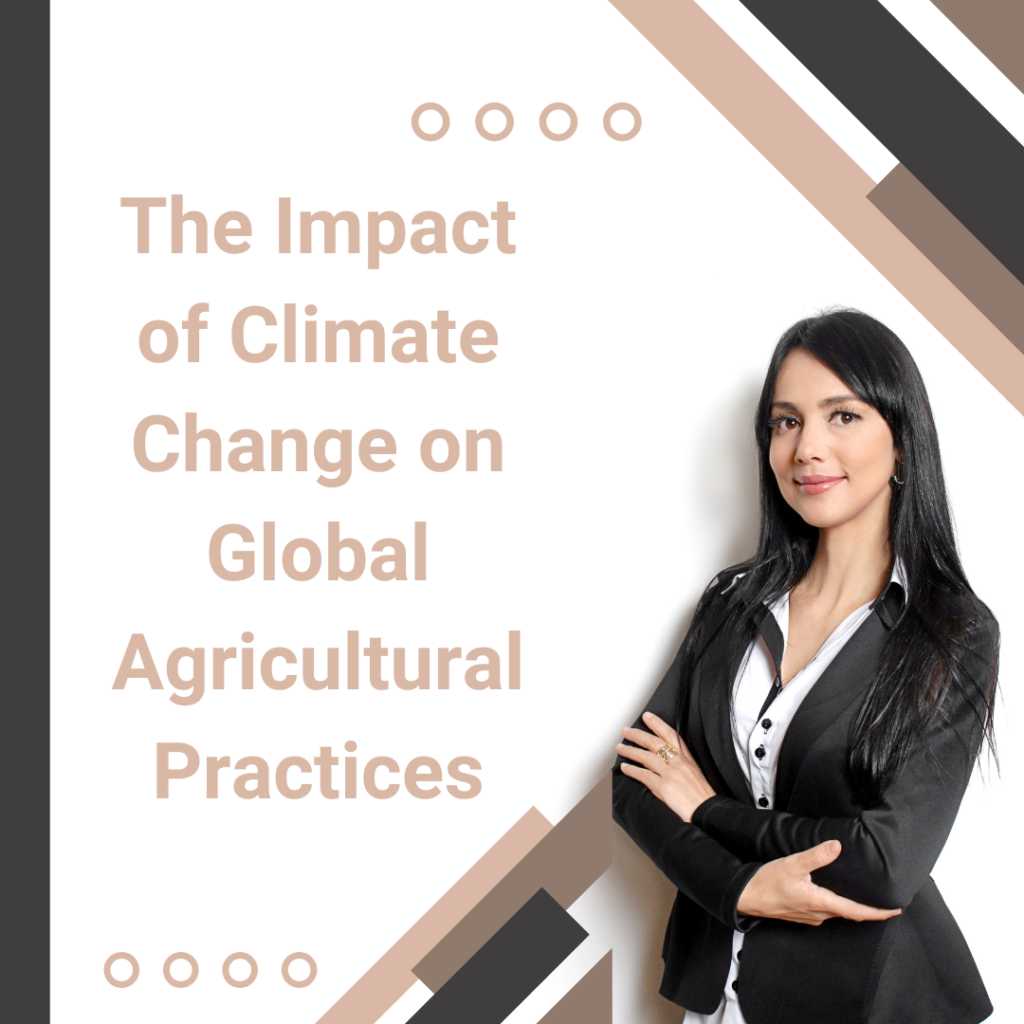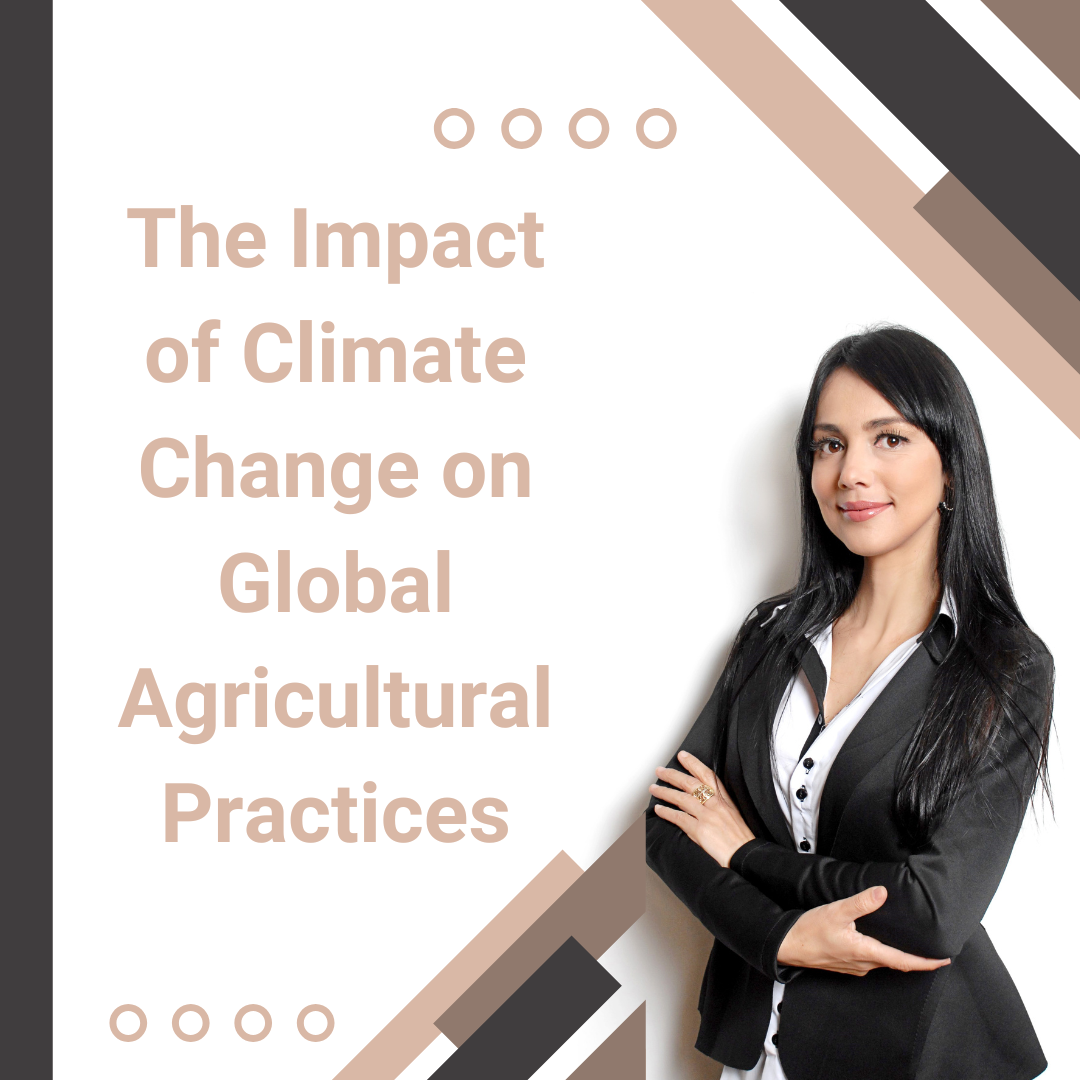The Impact of Climate Change on Global Agricultural Practices
Climate change has become one of the most worrying global issues in the 21st century-the consequences of which cut across ecosystems, economies, and societies. Agriculture-drawing most of its benefits from climate-is the most vulnerable to the effects of climate change. The global agricultural system is now faced with mounting challenges over food security and livelihoods and even economies because of the effects of increased temperature, changing precipitation patterns, and severe weather events. The Impact of Climate Change on Global Agricultural Practices.
As the climate changes, so do agricultural practices, with the aim of creating a more sustainable food supply that will not put any lives at risk of hunger and malnutrition.
This article discusses the profound effects of climate change on agricultural practices worldwide, establishes its effects on crop production, soil health, water resources, and pest management, and ends up on adaptation and mitigation.
The increase in temperatures:
The surging temperatures in the world are expected to increase further, thus bringing more and more frequent heat waves with higher averages throughout the year.
Changes in precipitation patterns:
Droughts in one part of the world become more intense while they are experiencing floods and increased rainfall in other places.
More Extreme Weather Events happen more often:
As oceans and atmospheres warm, hurricanes are expected to appear more frequently and more severe, storms and typhoons as well.
The rising level of the sea due to increasing atmospheric temperature due to melting polar ice caps and glaciers threatens all low-lying agricultural areas, especially in coastal regions. The Impact of Climate Change on Global Agricultural Practices.
These changes affect agriculture significantly at present, and in the absence of adaptation strategies, the impacts on global food security are likely to be very serious.
1. The Changing Climate: An Overview
The earth has undergone an enormous change in climate compared to a century ago. Changes to the climate have been evoked mostly by human activities such as permanent shedding of forests, fossil fuel consumption, and industrialization. These activities have contributed immensely to the increase in the concentration of greenhouse gases in the atmosphere. These gases, including carbon dioxide, methane, nitrogen dioxide, and others, are able to capture portions of the solar heat within the earth. According to the International Panel On Climate Change (IPCC), mean surface global temperature has increased about 1.2°C since the advent of modernization or the period of industrialization. This warming trend would not cease in the future.
Some of its wider repercussions would include:
2. Impact on Crop Production
Crop production depends on a variety of climatic components such as temperature, rainfall, and their timing. With the changes in temperature and rainfall due to climate change, crop yield and quality are in jeopardy. Some of the important impacts of climate change on crop production include:
A. Increased Temperature
Most crops have their optimal range of temperature for growth. Increasing temperatures, especially during critical growing periods, prove harmful for most crops. Wheat, corn, and rice are examples of crops that suffer highly from temperature fluctuations. For instance:
Wheat: High temperatures at the flowering stage of wheat growth expose it to heat stress that induces decreased grain filling and lowering in yield. Research indicates that a 1°C increase in ambient temperature diminishes wheat yields by 10% fallacy.
Corn: Corn is very sensitive to both heat and drought; as such, further increases in summer temperatures are expected to accompany reduced corn yields. Such areas may incur heavy losses, e.g. the corn-growing states in the Midwest of the United States.
Nighttime elevated temperatures would specifically diminish grain quality and yield and subsequently threaten global rice production. The Impact of Climate Change on Global Agricultural Practices.
In addition to the crop-specific effects, increased temperatures will also exacerbate the incidence and intensity of drought so that crop productivity will be further compromised.
B. Altered Rainfall Patterns and Water Stress
Another significant issue for agriculture due to changing patterns of rainfall is longer dry seasons during which parts may miss out on valuable water supplies. Other areas will see more than enough rain at times, resulting in flooding and waterlogging.
Droughts:
Increasing frequency and intensity of drought can cause a severe shortage of water especially in an already stressed region. Crops such as soybean, maize, and grapes, highly depend on consistently available water, but reduced supply of irrigation impairs the crop yield.
Flooding:
Intense rainfall coupled with floods destroys the crops, washes away soils, and interferes with planting/harvesting schedules. It further builds up the disease and pest incidence in crops, which adversely affects productivity.
In many areas, water availability is always a limiting factor in agricultural production. Climate change is anticipated to worsen this area because it will increase the difficulties posed by irrigation and competition between agriculture, industry, and residential use.
C. Shifting Growing Seasons
Growing season variations in their lengths have also been caused by the effects of climate change on when they commence and the time at which they end. On the other hand, warmer temperatures can actually lengthen a growing season; in this case, any such lengthening may not be predictable, and new risks may set in.
For example, in grapes from France or Italy, there were earlier harvests and the effects of the warm winter on the grapes. Other regions may benefit from prolonged growing seasons, but the inherent unpredictability of climate brings with it some risks that are difficult to manage.
3. Impact on Soil Health
Soeren Soil health is an essential factor for agricultural productivity because healthy soils provide food through nutrients, water retention, and ideal conditions for the development of plant roots. However, there are different ways via which climate change lowers the soil health status.
A. Soil Erosion
Extreme weather conditions, such as torrential rains coupled with storms, increase the tendency for soil erosion. Floods and heavy rains wash away topsoil, where most plant nutrients are concentrated, thus depleting fertility of the soil and rendering agricultural land unfit for use. The process which is accelerating through climate change by a greater frequency and intensity of weathering events is now becoming a greater threat to agriculture worldwide. The Impact of Climate Change on Global Agricultural Practices.
B. Reduced Soil Moisture
Higher temperatures and altered precipitation patterns mean reduced soil moisture in many regions. Drier soils mean poorer crop performance, as the plants act as though the water were not even there for them to access for growth. And then soil moisture stress caused by change in soil health is likely to aggravate reduced capacity for water retention because of moisture stress, and thus creates a vicious cycle of downward trend in partial soil fertility and crop yields.
C. Soil Acidification
Increased levels of CO2 in the atmosphere induce in some areas higher concentrations of carbonic acid in soils-a process referred to as soil acidification. The acidification negatively affects the soil microbial communities, who play a major role in nutrient cycling. Thus it reduces soil fertility while making the absorption of nutrients by the crops difficult, which in turn restricts yields.
4. Impact on Pest and Disease Dynamics
The increase in temperature and rise in humidity provide much more favorable conditions both for proliferation and become reservoirs for those that eventually damage the crops. Some of the changes that global warming is bringing pest and disease dynamics are:
A. Increase in Pest Ranges
Most of the pests particularly locusts, caterpillars, mosquitoes or any others thrive under warm temperatures. These are usually the pests in crop production that are expected to increase their range with rising global temperatures, moving further into newly affected areas where it has been known that crops are not familiar with their presence. Maize weevils and insect pests that predominantly thrive in tropical regions are migrating towards temperate countries due to warming conditions.
B. Increased Pressure by Diseases
Many plant disease symptoms, such as fungal infection or bacterial blight, are exacerbated with warm temperature and high humidity. It is through the rise in temperature that a pesticide is reduced in effectiveness because chemicals are becoming ever more quickly adapted by pests and diseases when the changes in weather-high temperature and relative humidity-increase to a great extent. Increasing disease and pest occurrence owing to climate change may make it difficult for farmers to manage crop yields and food quality.
C. Sustainable Agricultural Practices
Some negative impacts of climate change on agricultural practices can possibly be most effectively alleviated by adopting practices that are sustainable in agriculture, such as crop rotation, cover cropping, no-till farming, and agroforestry–all of which contribute to soil improvement, erosion reduction, and resilience to extremes of weather. Moreover, sustainable practices also minimize the carbon footprint of farming and use synthetic fertilizers by sequestering carbon in soil.
D. Integrated Pest Management (IPM)
It is an environmentally sustainable approach to pests’ management. Countries should develop their extension services to train farmers on implementing successful. IPM strategies instead of relying on agrochemical insect control solutions that rely a lot upon host recognition. Understanding how climate change changes pest dynamics would enable farmers to time. Their measures targeting pests early enough before reaching economic injury levels. This should lower usage of chemical pesticides while minimizing ecological impacts to pest control practices.
5. Adaptive Strategies for Agriculture
Resilient Crop Varieties. Perhaps the most promising solution to the problem of future food security. In an altered climate is the development of climate-resilient varieties. Genetic engineering or cyclisation, classical breeding, tidying crops to develop such as reduced drought and heat tolerance, and pest-proofing. Examples are drought maize and salt-resistant rice.
In addition, research is going on genetically modified crops that withstand weather extremes. Which will most likely come out as a healthy and namable option of sustaining yields creating areas. Where climate change threatens production through traditional agricultural practices.
Appropriately watered plants. On the crop-water management varies so much in importance. Now it is the most important aspect of agriculture that makes sure of having sufficient. Water in good health and proper growth to crops and avoids wasting water. Simple technologies applied in optimization of arboreal watering for labs and limited drought. Effects include drip irrigation, rainwater harvesting, and soil moisture sensors. Some others include using rainwater harvesting, mulching, reduced tillage, etc.
6. Conclusion
The climate is slowly penetrating so deeply and generally into. The agriculture activities of the world- from crop yield, soil health, availability, and quality of water, and to pest dynamics- as a threat. Unfortunately, the effect in terms of threat to food security is much more pertinent to those regions. That were already shortend into the boundaries of food supply. By adopting it into a sustainable agricultural practice.
By farmers collectively with governments and scientists. A full-fledged article on climate change and agriculture, highlighting. Through research and innovations, along with policy interventions, to feed an ever-increasing population. In the context of global warming and changing climates.


